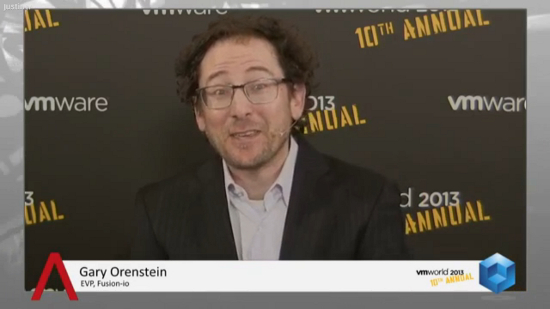 NEWS
NEWS
 NEWS
NEWS
 NEWS
NEWS
Gary Orenstein, EVP at Fusion-io, discussed virtualization trends and the role of flash in delivering fast data, with theCUBE co-hosts Dave Vellante and John Furrier, live at VMWorld 2013. See the entire segment below.
![]()
One of the main benefits driving server virtualization, according Orenstein, is “the flexibility that you get with these configurations” when it comes to moving data, growing at scale, compared with how things used to be done in the past. The large number of people demonstrating their use cases at VMWorld supports that point of view.
Discussing Fusion-io’s role in pioneered flash, Orenstein said “the industry has come a great way. We are about delivering the data world faster,” changing the shape of the data center, reducing the amount of infrastructure from a cost perspective. “When you reduce the cost of computing, you increase the size of the market.”
As far as Fusion-io developments are concerned, as the competition in the flash market increases, the company has dramatically increased its portfolio, adding shared solutions, and a suite of virtualized solutions for both servers and desktops. “We haven’t seen folks that they can offer such choice for their customers, not only about the products, but also the deployment method,” he explained.
“The web is the engine of innovation, but the enterprise is the engine of our economy,” Orenstein said. Across the spectrum of enterprise solutions, “we have a lot of activity in the database market. Server virtualization and virtual desktops are a big market for us.” The company has seen increased adoption of the Big Data noSQL databases, such as MongoDB. The company’s philosophy when addressing customers is to “give them choice of deployment and help reduce cost.”
“There is a fixed stack in term of the applications that go into the storage,” on VMware’s side, while their focus is still on increasing the main stream functionality. Extreme server density with flash as a cache, while maintaining security and disaster recovery services, is the approach to follow. One of the big focuses of the Fusion-io solutions is “if you have a storage system that you know and love, don’t change it. We want to help accelerate it.”
Asked what was the future of the data center, Orenstein said it was the “fully automated software-defined data center,” which will be an “all flash data center.” The definition of an all flash data center does not entail the death of tape or disk. “It’s much easier to predict the arrival of new media than the death of old media.” What it refers to is the full adoption of flash, “the active data set, that has to be in flash.”
“From the get go, Fusion-io made a decision that we are going to look at flash as memory, not as a disk drive. We really try to exploit the media to do all that it can do.” The goal is to provide “highest performance to the lowest over all cost for our customers.” He also predicted more memory-centric architectures in the future.
Support our mission to keep content open and free by engaging with theCUBE community. Join theCUBE’s Alumni Trust Network, where technology leaders connect, share intelligence and create opportunities.
Founded by tech visionaries John Furrier and Dave Vellante, SiliconANGLE Media has built a dynamic ecosystem of industry-leading digital media brands that reach 15+ million elite tech professionals. Our new proprietary theCUBE AI Video Cloud is breaking ground in audience interaction, leveraging theCUBEai.com neural network to help technology companies make data-driven decisions and stay at the forefront of industry conversations.